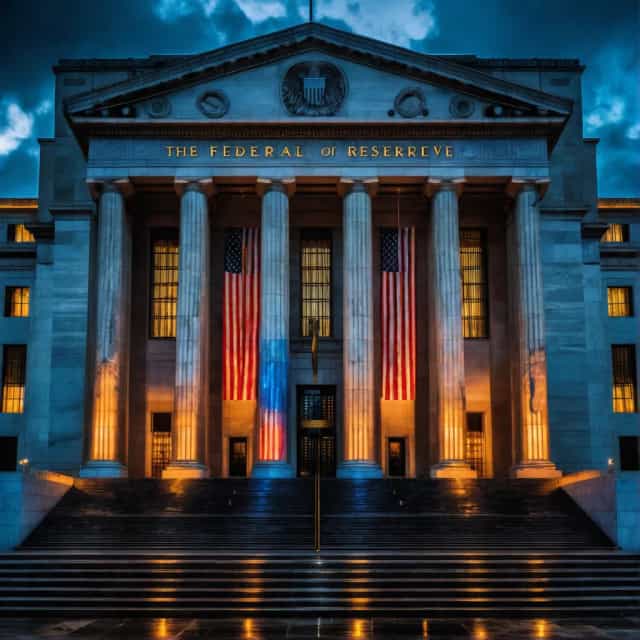
Image source: Block Media
Growing Expectations for Aggressive Rate Cuts as Markets Signal Two 0.5% Reductions
The U.S. bond and options markets are increasingly aligning with the prospect of the Federal Reserve implementing substantial interest rate cuts before the year’s end. As anticipation builds ahead of the Federal Open Market Committee (FOMC) meeting, set for August 17, traders are hedging against the potential for not just moderate easing but a more aggressive monetary policy shift. The consensus view of a 0.25-percentage-point cut is now being challenged by mounting bets on two significant 0.5% rate reductions—an indication of heightened concern over economic vulnerabilities.
Markets Anticipate Aggressive Easing Amid Slowing Growth
The upcoming FOMC meeting is widely expected to initiate the Fed's first interest rate adjustment of the year. While most forecasts point to a modest 0.25% reduction, deepening fears around a cooling labor market and weakening economic expansion are stoking speculation around more decisive action. This has prompted heightened activity across the options market as traders prepare for the possibility of faster and deeper monetary easing.
Such concerns appear justified: recent economic data suggests cracks developing in job creation and consumption, two key pillars of U.S. growth. The intensified market positioning reflects a strategic shift as institutional and retail investors alike hedge against heightened economic uncertainty.
SOFR Options Signal Two 0.5% Rate Cuts
The Secured Overnight Financing Rate (SOFR) options market, a key barometer for short-term interest rate expectations, has emerged at the center of the rate-cut debate. Particularly active have been December 2025 SOFR options with a strike price of 96.50, which have seen elevated call and put activity over the past week. This activity signals traders’ belief in either three 0.25-percentage-point cuts or two significant 0.5% reductions across upcoming FOMC meetings in September, October, and December.
Adding further insight into market sentiment, complex derivatives strategies—such as call condors and put trees—are being deployed by institutional players to account for these scenarios. Open interest has surged at specific strike prices, including options expiring in March and June 2026, with the SOFR 96.50 strike emerging as the market frontrunner for hedging activity.
Derivatives Data Suggests Markets Are Betting on Bold Moves
The tone of the derivatives market indicates expectations are growing for the Fed to deliver more aggressive policy shifts sooner rather than later. On Monday, a record-setting block trade of 84,000 contracts in the Fed funds futures market underscored this sentiment. This trade, interpreted as a hedge against an imminent 0.5-percentage-point cut, highlights the cautious optimism of market participants as they await confirmation from policymakers.
Economists at Standard Chartered have added their voices to the discussion, predicting a potential “catch-up cut” of 0.5 percentage points during this week’s meeting due to persistent softness in labor data. However, they also caution that Fed Chair Jerome Powell is unlikely to signal a clear trajectory for future policy changes, given ongoing divisions within the FOMC regarding the pace and magnitude of cuts.
Political Factors Add a Layer of Complexity
The political landscape further complicates the outlook for monetary policy. President Donald Trump has ramped up criticism of the Federal Reserve's decision-making, pushing for more aggressive rate reductions to bolster the slowing economy. Additionally, the recent appointment of Fed Governor Steven Miran, a fiscal-policy advocate with ties to the Trump administration, introduces a new voice into the central bank’s discussions. This internal reshuffling may shift the balance of power among dovish and hawkish members of the Fed, potentially influencing upcoming decisions.
Meanwhile, divergence between different segments of the financial markets has grown. Interest rate swaps, for example, currently imply a more conservative 0.70-percentage-point cut by year-end. This stands in contrast to options market pricing, which suggests as much as 1.0 percentage point in reductions. The discrepancy highlights varied expectations about how the Fed will adapt its policies amid mounting pressures from both economic challenges and political forces.
FOMC Meeting to Shape Rate Trajectory
The outcome of the August FOMC meeting and Powell's accompanying commentary will likely prove pivotal in shaping expectations for future rate adjustments. As the stakes rise, markets are braced for a shift in Fed policy the likes of which has not been seen in recent years. Whether the central bank opts for cautious tinkering or bold action, the decisions made will resonate far beyond the confines of the options and bond markets, influencing economic sentiment on a broader scale.










